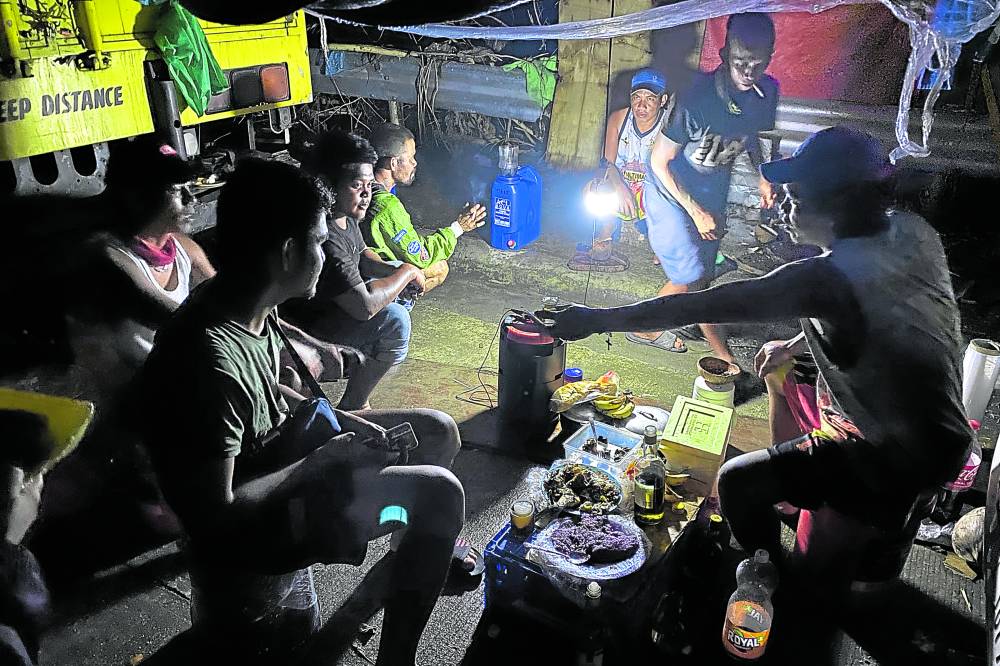Death toll from Super Typhoon Rai passes 400 – People in wrecked city of Surigao see hope in New Year amid typhoon ruins

By Divina M. Suson and Erwin M. Mascariñas
2 January 2022
SURIGAO CITY, Surigao del Norte, Philippines (Philippine Daily Inquirer) – When asked about their fishing boats during a disaster damage assessment just days after Typhoon Odette (international name: Rai) struck on 16 December 2021, many fishermen in the city’s coastal villages replied, “zero visibility.”
When pressed what they meant, City Administrator Jerry Centro said the fishermen explained that many of them could not see a trace of their boats after the typhoon’s onslaught. “Waya nay bisibol, sir (Nothing is visible, sir),” Centro recalled how the fishers put it into a joke.
Couple Diosdado and Catherine Petilo, who make a living as ambulant vendors, recounted that as winds became stronger and rains heavier, they stayed inside their house, heads bowed in prayer and unmindful about the worst that could happen.
As Odette’s fury weakened by nightfall, Catherine said it was only then that they noticed they were drenched.
“When we looked up, we noticed our house was already roofless,” Catherine, chuckling, narrated in the dialect. She added that it was fortunate that the entire roof got blown away because had it crumbled, they could have been harmed.
After the harrowing experience from the storm, whose strength many in Surigao never encountered in their lifetime, the survivors’ ability to take misfortune lightly and see the brighter side of things indicated a resilient attitude that bodes well for their eventual recovery.
Immediately after the storm, many families who had nowhere to go for the night gathered what remained of their damaged houses and put up makeshift shelters where their homes used to stand or near roads. They did this aided only by flashlights as power supply was already cut off.
Odette left an enormous trail of destruction in the city: 23,738 houses destroyed, 19,424 damaged, and 50,957 families affected.
Mayor Ernesto Matugas Jr. said that practically everybody who lived in the city suffered Odette’s wrath.
Amid such landscape of ruin and despair, the strong community spirit among Surigao residents lightened the burden and helped others bounce back. [more]
Surigao folk see hope in New Year amid typhoon ruins
Philippine death toll from its strongest typhoon of year tops 400

By Neil Jerome Morales and Karen Lema; editing by Ed Davies
31 December 2021
MANILA (Reuters) – The Philippine death toll from Typhoon Rai has crossed the 400 mark, the disaster agency said on Friday, as officials in some hard-hit provinces appealed for more supplies of food, water and shelter materials about two weeks after the storm struck.
Rai was the 15th and deadliest typhoon to hit the Southeast Asian nation this year.
Reported deaths had reached 405, mostly due to drowning, fallen trees and landslides, Ricardo Jalad, chief of the national disaster agency, told a news conference. He said 82 were missing and 1,147 injured.
More than 530,000 houses were damaged, a third of which were totally wrecked, while damage to infrastructure and agriculture was estimated at 23.4 billion pesos ($459 million), Jalad said.
The typhoon affected nearly 4.5 million people, including about 500,000 sheltering in evacuation centres, government data showed. It made landfall as a category 5 typhoon on Dec. 16, and left a trail of destruction in the provinces of Bohol, Cebu, and Surigao del Norte, including the holiday island of Siargao, and the Dinagat Islands.
In central Philippine provinces, disaster and government officials have been grappling with inadequate relief supplies for thousands of residents still without power and water.
“It caused massive destruction and it was like a bomb was dropped in northern Bohol,” Anthony Damalerio, chief of Bohol province’s disaster agency, told Reuters.
A popular dive spot, Bohol reported 109 deaths and is seeking shelter kits, food, and water, Damalerio said.
“Our problem is shelter, those who lost roofs, especially now that this is rainy season in the province,” Surigao del Norte Governor Francisco Matugas told ANC news channel.
Rai’s swath of destruction revived memories of typhoon Haiyan, one of the most powerful tropical cyclones ever recorded, which killed 6,300 people in the Philippines in 2013.
Philippine death toll from its strongest typhoon of year tops 400


